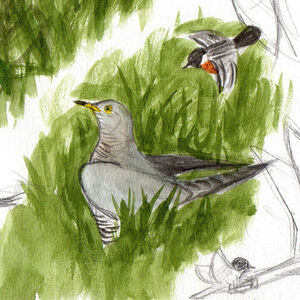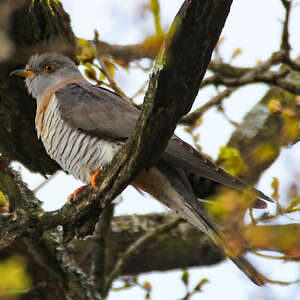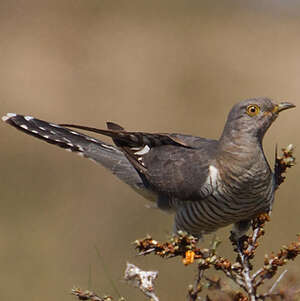Common Cuckoo
Cuculus canorus - Coucou gris
Identification
The adult male Common Cuckoo and most adult females have a grey plumage. The upperparts are a uniform medium grey. The head, neck, and upper breast is a lighter grey. The long wings and tail are a pronounced slate grey. The underparts are white, tinted with cream on the belly and undertail. The chest and flanks are finely barred with grey. The long, crescent-shaped tail is clearly spotted and white-tipped. The iris is yellow with a clearly visible yellow eye-ring. The bill is black with yellow at the base. The feet (tarses and toes) are short and yellow. Females often have the upper breast more or less tinged with rufous. A part of adult females of the 'canorus' ssp. show a typical brown-rufous morph referred to as 'hepatic'. The back and rump are a vivid reddish when seen in flight. These birds are easy to identify. Immature plumages can be very confusing and a description is not useful as they mainly occur in wintering areas. Juvenile plumage clearly differs from adult plumage. The upperparts are a rich brown. The feathers (feathers as well as coverts) have beige or fawn barred ends and white tips, making the young bird cryptic and helping its camouflage.
Subspecific information 4 subspecies
- Cuculus canorus canorus (Europe and the Middle East to Kamchatka, Japan and n China)
- Cuculus canorus bangsi (Iberian Pen., Balearic Is. and nw Africa)
- Cuculus canorus subtelephonus (Turkmenistan to s Mongolia)
- Cuculus canorus bakeri (w China and n India to s China and nw Thailand)
Foreign names
- Coucou gris,
- Cuco común,
- cuco-canoro,
- Kuckuck,
- kakukk,
- Koekoek,
- Cuculo,
- gök,
- Gjøk,
- kukučka obyčajná,
- kukačka obecná,
- Gøg,
- käki,
- Europese Koekoek,
- cucut comú,
- Gaukur,
- kukułka (zwyczajna),
- dzeguze,
- kukavica,
- Кукушка,
- Kangkok erasia,
- カッコウ,
- 大杜鹃,
- นกคัคคูพันธุ์ยุโรป,
- 大杜鵑,
Voice song and call
The male Common Cuckoo's song is the well-known coo-coo call, of a high tone, the first note being slightly higher than the second. This song is uttered almost with a closed beak, opening only slightly for the first note. It may happen that the first note can be doubled in excitement, coo-coo-coo. The phrase sometimes ends in a sequence of 3 or 4 harsh notes: Hah hah hah hah. The female responds with a rapid succession of bursting sharp notes, gradually decreasing: couikcouikcouikcouik....
Habitat
The Common Cuckoo frequents a wide variety of habitats, from deciduous and coniferous wooded areas to grassland and marshland, provided there is at least some shrubby vegetation. In higher altitudes, it can be found from the coast to alpine meadows, at the upper edge of the forest. It has a preference for humid environments, particularly around bodies of water such as rivers and marshes. It appreciates open perches from which to sing and monitor its territory.
Behaviour character trait
The Common Cuckoo is a great nocturnal migrant. European birds travel to Africa beginning in July for adults and up to October for juveniles, not only by conventional routes such as the Strait of Gibraltar and the Middle East, but also by more hazardous routes such as Italy and Sicily or Greece via Crete, with a long flight over the Mediterranean.
In Africa, the birds gradually travel down to the center and south of the continent. The return to the breeding sites mostly takes place in April-May, announced by the male's loud cuckoo calls, but it can be thought that silent precursors preceded them by several days. The species' major behavioural characteristic is of course its parasitic reproduction mode (see further). This makes one think. We willingly imagine that a young bird needs the example of its parents and other members of the species to acquire the foundations of its future behaviour. And so, the cuckoo example shows us the importance of the innate and the instinct in a bird's life. Although the young cuckoo was raised by adoptive parents (wren, robin, etc.) very different from its own parents, he will not look for company from the former once sexual maturity comes, but he will turn towards members of his own species. Therefore he has not been imprinted by the host species.Flight
The Common Cuckoo has a falcon-like silhouette, but its flight is very different from that of a falcon, making it easily distinguishable. This flight is fast and direct, powered by rapid beats with low amplitude. It can be maintained for long distances and is utilized during transcontinental migrations.
Dietfeeding habits
The Common Cuckoo is an insectivore. It feeds on large insects and their larvae, especially lepidopterans. Hairy caterpillars are not repugnant to it. Also included in its diet are orthopterans, coleopterans, dipterans, spiders, small molluscs and even eggs and chicks of small passerines. It captures its prey on the ground or in vegetation.
Reproduction nesting
As with a number of other members of the cuckoo family, the Common Cuckoo is a brood parasite. The female lays her eggs in the nest of other species, primarily small passerine. In Europe, it is often the nest of the Eurasian Reed Warbler that is parasitized. It is easy to spot in a reed bed. The House Sparrow's nest works just as well in other habitats. Overall, it has been shown that more than 100 species of small passerines can be parasitized across its vast range. The female, when laying, deposits one egg per day in different nests. This egg is small in size (23 x 17 mm) in order to resemble those of the host and is often mimetic in order to deceive the latter.
The incubation period is short (11 to 12 days), which means that the young cuckoo hatches either simultaneously or even before the young of the host. When it hatches, the young cuckoo has a reflex to eject everything from the nest so that it ends up alone. Nature has endowed it with a depression on its back which collects and ejects eggs or young chicks of the host one after the other. It is then taken care of and fed by its adoptive parents as if nothing had happened, which shows the very instinctive and thoughtless behavior of birds. The young cuckoo stays in the nest for 17 to 18 days, after which it will remain dependent for another 2 to 3 weeks. Do not assume that all eggs laid go well. There is a rejection rate of the parasite's egg, whether mimetic or not. It has been shown that with ground-nesting species, the rejection rate is lower. Some parasitized species are more tolerant of the parasite than others, such as the Eurasian Reed Warbler or the familiar House Sparrow. To compensate for the hazards of reproduction, the female cuckoo must be prolific and lay enough eggs to ensure a demographic balance.Geographic range
The Common Cuckoo has a wide distribution in Eurasia, from the British Isles to Kamchatka and Japan, from the North Cape to the Maghreb and from Siberia to northern Indochina and southern China. 4 subspecies share this space. The wintering area is disconnected. The cuckoo winters in Africa south of the Sahara, in India and in southern and southeastern Asia.
Threats - protection
IUCN conservation status
concern
in the Wild
threatened
evaluated
Even though it has been confirmed that the species has declined over the last few decades, the Common Cuckoo is still a very common species, not globally threatened, but we must remain alert for its future due to climate change and the use of pesticides.
Sources of information
- IOC World Bird List (v15.1), Gill, F and D Donsker (Eds). 2025-12-07.
- The cuckoos, Robert B Payne
- Les passereaux d'Europe, tome 1, P. Géroudet, M. Cuisin
- Birds of the World, The Cornell Lab of Ornithology
- xeno-canto, Sharing bird sounds from around the world,
Other sources of interest
 Specification sheet created on
12/07/2023 by Jean François
Specification sheet created on
12/07/2023 by Jean FrançoisTranslation by AI Oiseaux.net
© 1996-2025 Oiseaux.net
- Accipitriformes
- Aegotheliformes
- Anseriformes
- Apodiformes
- Apterygiformes
- Bucerotiformes
- Caprimulgiformes
- Cariamiformes
- Casuariiformes
- Charadriiformes
- Ciconiiformes
- Coliiformes
- Columbiformes
- Coraciiformes
- Cuculiformes
- Eurypygiformes
- Falconiformes
- Galliformes
- Gaviiformes
- Gruiformes
- Leptosomiformes
- Mesitornithiformes
- Musophagiformes
- Nyctibiiformes
- Opisthocomiformes
- Otidiformes
- Passeriformes
- Pelecaniformes
- Phaethontiformes
- Phoenicopteriformes
- Piciformes
- Podargiformes
- Podicipediformes
- Procellariiformes
- Psittaciformes
- Pterocliformes
- Rheiformes
- Sphenisciformes
- Steatornithiformes
- Strigiformes
- Struthioniformes
- Suliformes
- Tinamiformes
- Trogoniformes

































